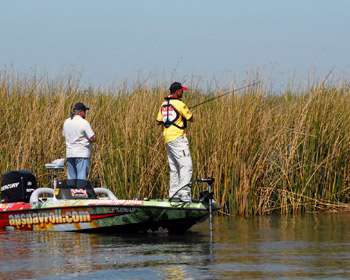
The conventional safety pin-style spinnerbait isn't going away anytime soon. Take a look in the boat of any Elite Series competitor and you'll see a wide variety of spinnerbaits in every color, size and blade configuration under the sun.
The weekend angler would be wise to emulate this hyper-preparedness. But in the last few years we've also seen the emergence of the ChatterBait lure, also known as a bladed jig, and its many imitators. It excels in many of the same situations as the traditional spinnerbait. So how do you know when to use one and when to use the other? Texas-based Elite Series pro James Niggemeyer has developed a simple system that allows him to choose which bait to start with.
He stresses that it's not 100 percent foolproof — after all, nothing in fishing is guaranteed — but it'll work to stack the odds in your favor. "I typically start with a spinnerbait when there are overcast or low light conditions or wind," he says. "You really need something that'll disguise the blades and tone down all of that flash." Conversely, he dotes on a bladed jig around the same types of cover even when conditions are less favorable to a spinnerbait.
"You can get away with that type of bait on those sunnier days or flatter days," he says. "That's when I reach for a Strike King Pure Poison around grass or stumps or anyplace that vibration really starts to shine.
There are instances where I take that Pure Poison and fish it on days when I'd never even consider a spinnerbait. You can get away with it to search that same zone that would be effective with a spinnerbait." He also noted that whether it's the novelty of this genre of lures or something inherent in their action, the ChatterBait-style lures seem to out-produce traditional spinnerbaits under certain clearly defined circumstances. "While the spinnerbait does work well in a lot of the same situations, the vibrating jig seems to be really more effective around grass, whether it's hydrilla or coontail or something else," he says. "Also, it excels in schooling-type applications where fish are grouping either in small wolf packs or really big schools pushing bait.
That's when it can really be more effective." He does make the simple modification of adding a trailer hook to both lure categories as soon as he takes them out of the box, but with the Pure Poison he always goes one step further: "I want a trailer of some sort, whether it's a twin-tail trailer or a curly-tail grub or some type of swimming body I want something like that to increase the profile and give it a little more of a shad-type and full-bodied look."
So while no one is telling you to throw away your spinnerbaits now, if you can remember three conditions — CALM, GRASS and SCHOOLING — you'll know when it's time to tie on a bladed jig and start cranking.
(Provided by Z3 Media)





